MGT200: Servant Leadership Management Style - Pros, Cons & Analysis
VerifiedAdded on 2023/05/28
|7
|2302
|295
Essay
AI Summary
This essay provides a detailed analysis of the servant leadership management style, exploring its advantages and disadvantages in the context of organizational behavior. The essay discusses the benefits of servant leadership, such as prioritizing the needs of employees, fostering a sense of ...

Running Head: SERVANT LEADERSHIP 0
Servant Leadership Management Style
Student Name
[Pick the date]
Servant Leadership Management Style
Student Name
[Pick the date]
Paraphrase This Document
Need a fresh take? Get an instant paraphrase of this document with our AI Paraphraser
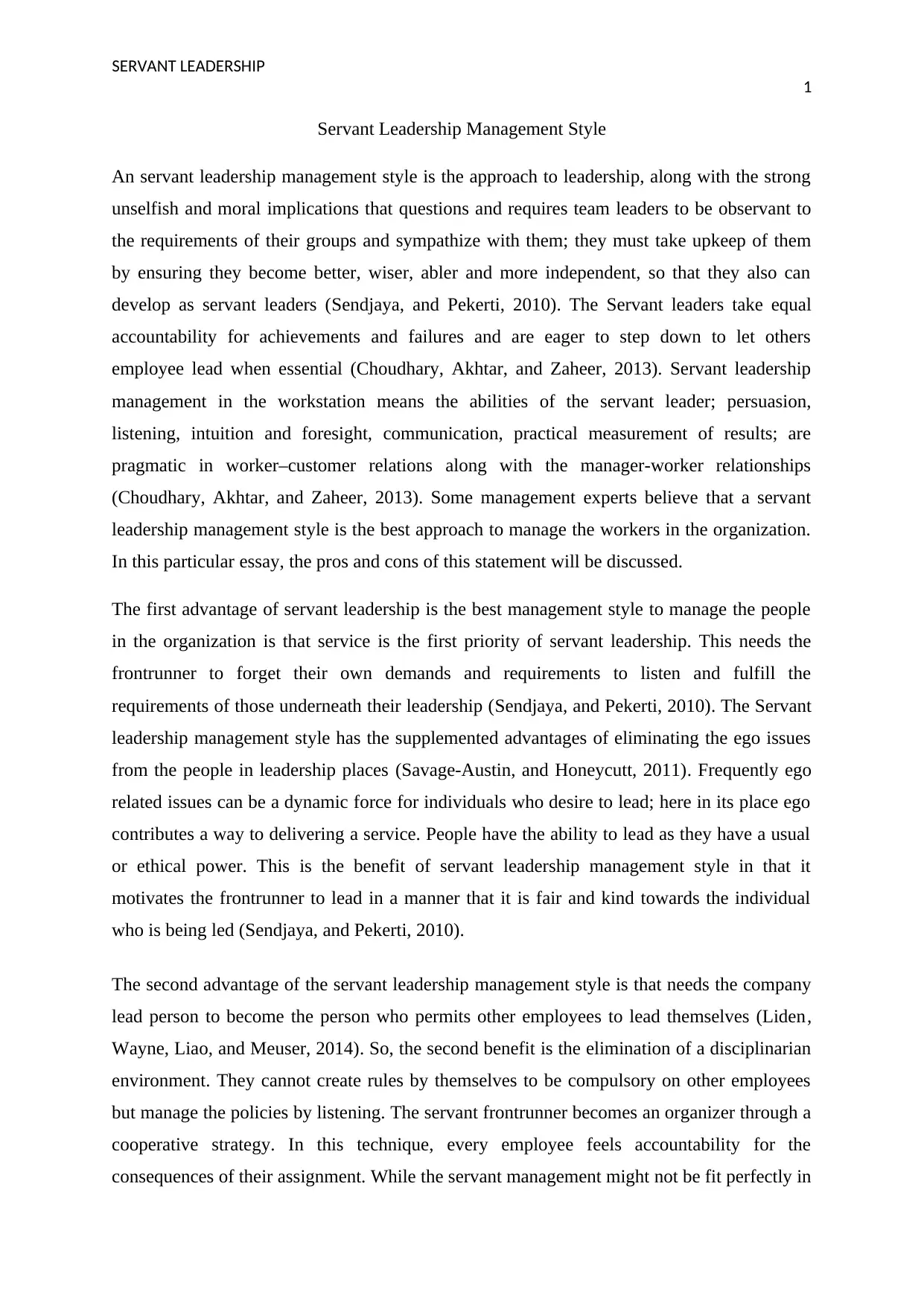
SERVANT LEADERSHIP
1
Servant Leadership Management Style
An servant leadership management style is the approach to leadership, along with the strong
unselfish and moral implications that questions and requires team leaders to be observant to
the requirements of their groups and sympathize with them; they must take upkeep of them
by ensuring they become better, wiser, abler and more independent, so that they also can
develop as servant leaders (Sendjaya, and Pekerti, 2010). The Servant leaders take equal
accountability for achievements and failures and are eager to step down to let others
employee lead when essential (Choudhary, Akhtar, and Zaheer, 2013). Servant leadership
management in the workstation means the abilities of the servant leader; persuasion,
listening, intuition and foresight, communication, practical measurement of results; are
pragmatic in worker–customer relations along with the manager-worker relationships
(Choudhary, Akhtar, and Zaheer, 2013). Some management experts believe that a servant
leadership management style is the best approach to manage the workers in the organization.
In this particular essay, the pros and cons of this statement will be discussed.
The first advantage of servant leadership is the best management style to manage the people
in the organization is that service is the first priority of servant leadership. This needs the
frontrunner to forget their own demands and requirements to listen and fulfill the
requirements of those underneath their leadership (Sendjaya, and Pekerti, 2010). The Servant
leadership management style has the supplemented advantages of eliminating the ego issues
from the people in leadership places (Savage-Austin, and Honeycutt, 2011). Frequently ego
related issues can be a dynamic force for individuals who desire to lead; here in its place ego
contributes a way to delivering a service. People have the ability to lead as they have a usual
or ethical power. This is the benefit of servant leadership management style in that it
motivates the frontrunner to lead in a manner that it is fair and kind towards the individual
who is being led (Sendjaya, and Pekerti, 2010).
The second advantage of the servant leadership management style is that needs the company
lead person to become the person who permits other employees to lead themselves (Liden,
Wayne, Liao, and Meuser, 2014). So, the second benefit is the elimination of a disciplinarian
environment. They cannot create rules by themselves to be compulsory on other employees
but manage the policies by listening. The servant frontrunner becomes an organizer through a
cooperative strategy. In this technique, every employee feels accountability for the
consequences of their assignment. While the servant management might not be fit perfectly in
1
Servant Leadership Management Style
An servant leadership management style is the approach to leadership, along with the strong
unselfish and moral implications that questions and requires team leaders to be observant to
the requirements of their groups and sympathize with them; they must take upkeep of them
by ensuring they become better, wiser, abler and more independent, so that they also can
develop as servant leaders (Sendjaya, and Pekerti, 2010). The Servant leaders take equal
accountability for achievements and failures and are eager to step down to let others
employee lead when essential (Choudhary, Akhtar, and Zaheer, 2013). Servant leadership
management in the workstation means the abilities of the servant leader; persuasion,
listening, intuition and foresight, communication, practical measurement of results; are
pragmatic in worker–customer relations along with the manager-worker relationships
(Choudhary, Akhtar, and Zaheer, 2013). Some management experts believe that a servant
leadership management style is the best approach to manage the workers in the organization.
In this particular essay, the pros and cons of this statement will be discussed.
The first advantage of servant leadership is the best management style to manage the people
in the organization is that service is the first priority of servant leadership. This needs the
frontrunner to forget their own demands and requirements to listen and fulfill the
requirements of those underneath their leadership (Sendjaya, and Pekerti, 2010). The Servant
leadership management style has the supplemented advantages of eliminating the ego issues
from the people in leadership places (Savage-Austin, and Honeycutt, 2011). Frequently ego
related issues can be a dynamic force for individuals who desire to lead; here in its place ego
contributes a way to delivering a service. People have the ability to lead as they have a usual
or ethical power. This is the benefit of servant leadership management style in that it
motivates the frontrunner to lead in a manner that it is fair and kind towards the individual
who is being led (Sendjaya, and Pekerti, 2010).
The second advantage of the servant leadership management style is that needs the company
lead person to become the person who permits other employees to lead themselves (Liden,
Wayne, Liao, and Meuser, 2014). So, the second benefit is the elimination of a disciplinarian
environment. They cannot create rules by themselves to be compulsory on other employees
but manage the policies by listening. The servant frontrunner becomes an organizer through a
cooperative strategy. In this technique, every employee feels accountability for the
consequences of their assignment. While the servant management might not be fit perfectly in
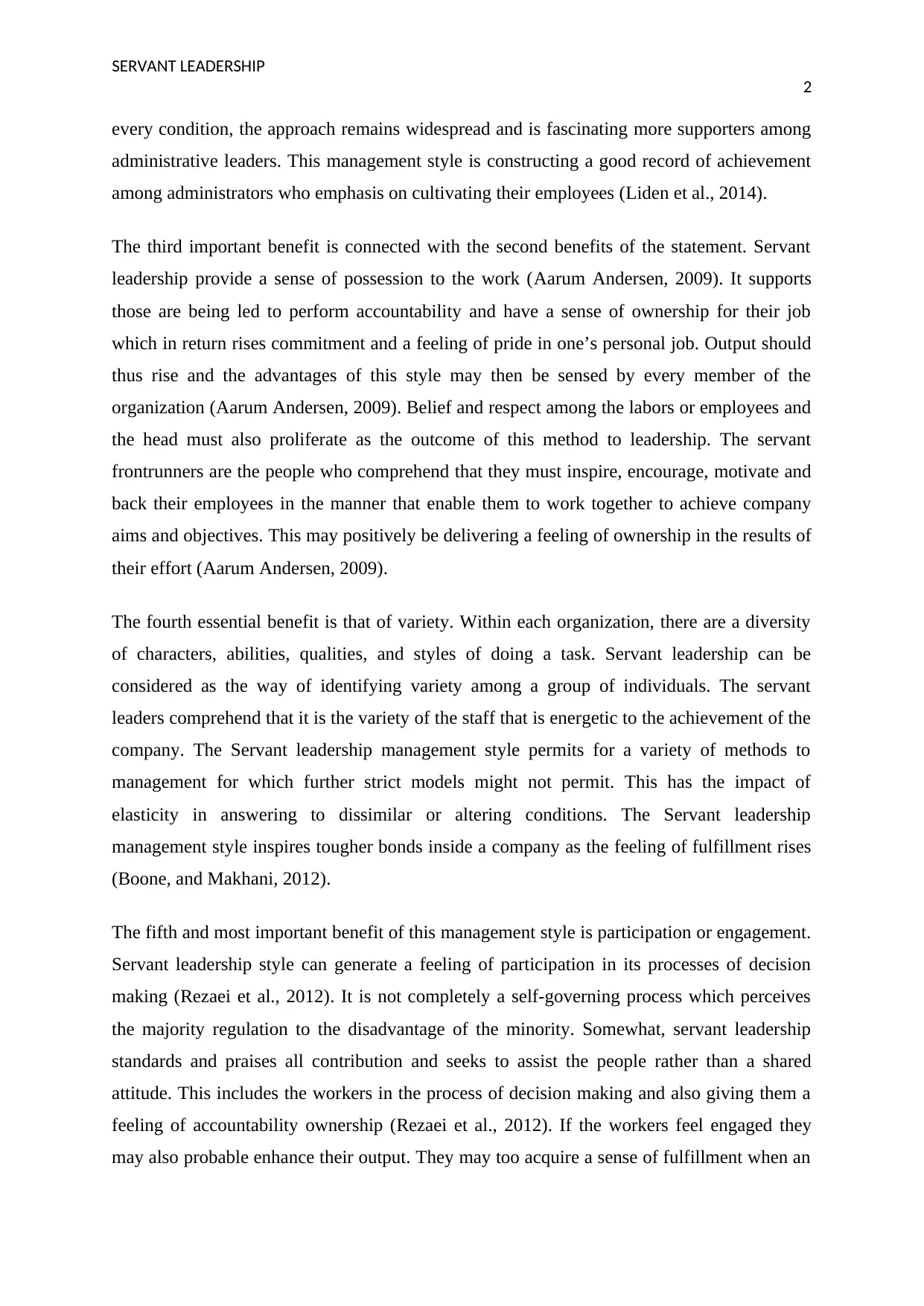
SERVANT LEADERSHIP
2
every condition, the approach remains widespread and is fascinating more supporters among
administrative leaders. This management style is constructing a good record of achievement
among administrators who emphasis on cultivating their employees (Liden et al., 2014).
The third important benefit is connected with the second benefits of the statement. Servant
leadership provide a sense of possession to the work (Aarum Andersen, 2009). It supports
those are being led to perform accountability and have a sense of ownership for their job
which in return rises commitment and a feeling of pride in one’s personal job. Output should
thus rise and the advantages of this style may then be sensed by every member of the
organization (Aarum Andersen, 2009). Belief and respect among the labors or employees and
the head must also proliferate as the outcome of this method to leadership. The servant
frontrunners are the people who comprehend that they must inspire, encourage, motivate and
back their employees in the manner that enable them to work together to achieve company
aims and objectives. This may positively be delivering a feeling of ownership in the results of
their effort (Aarum Andersen, 2009).
The fourth essential benefit is that of variety. Within each organization, there are a diversity
of characters, abilities, qualities, and styles of doing a task. Servant leadership can be
considered as the way of identifying variety among a group of individuals. The servant
leaders comprehend that it is the variety of the staff that is energetic to the achievement of the
company. The Servant leadership management style permits for a variety of methods to
management for which further strict models might not permit. This has the impact of
elasticity in answering to dissimilar or altering conditions. The Servant leadership
management style inspires tougher bonds inside a company as the feeling of fulfillment rises
(Boone, and Makhani, 2012).
The fifth and most important benefit of this management style is participation or engagement.
Servant leadership style can generate a feeling of participation in its processes of decision
making (Rezaei et al., 2012). It is not completely a self-governing process which perceives
the majority regulation to the disadvantage of the minority. Somewhat, servant leadership
standards and praises all contribution and seeks to assist the people rather than a shared
attitude. This includes the workers in the process of decision making and also giving them a
feeling of accountability ownership (Rezaei et al., 2012). If the workers feel engaged they
may also probable enhance their output. They may too acquire a sense of fulfillment when an
2
every condition, the approach remains widespread and is fascinating more supporters among
administrative leaders. This management style is constructing a good record of achievement
among administrators who emphasis on cultivating their employees (Liden et al., 2014).
The third important benefit is connected with the second benefits of the statement. Servant
leadership provide a sense of possession to the work (Aarum Andersen, 2009). It supports
those are being led to perform accountability and have a sense of ownership for their job
which in return rises commitment and a feeling of pride in one’s personal job. Output should
thus rise and the advantages of this style may then be sensed by every member of the
organization (Aarum Andersen, 2009). Belief and respect among the labors or employees and
the head must also proliferate as the outcome of this method to leadership. The servant
frontrunners are the people who comprehend that they must inspire, encourage, motivate and
back their employees in the manner that enable them to work together to achieve company
aims and objectives. This may positively be delivering a feeling of ownership in the results of
their effort (Aarum Andersen, 2009).
The fourth essential benefit is that of variety. Within each organization, there are a diversity
of characters, abilities, qualities, and styles of doing a task. Servant leadership can be
considered as the way of identifying variety among a group of individuals. The servant
leaders comprehend that it is the variety of the staff that is energetic to the achievement of the
company. The Servant leadership management style permits for a variety of methods to
management for which further strict models might not permit. This has the impact of
elasticity in answering to dissimilar or altering conditions. The Servant leadership
management style inspires tougher bonds inside a company as the feeling of fulfillment rises
(Boone, and Makhani, 2012).
The fifth and most important benefit of this management style is participation or engagement.
Servant leadership style can generate a feeling of participation in its processes of decision
making (Rezaei et al., 2012). It is not completely a self-governing process which perceives
the majority regulation to the disadvantage of the minority. Somewhat, servant leadership
standards and praises all contribution and seeks to assist the people rather than a shared
attitude. This includes the workers in the process of decision making and also giving them a
feeling of accountability ownership (Rezaei et al., 2012). If the workers feel engaged they
may also probable enhance their output. They may too acquire a sense of fulfillment when an
⊘ This is a preview!⊘
Do you want full access?
Subscribe today to unlock all pages.

Trusted by 1+ million students worldwide
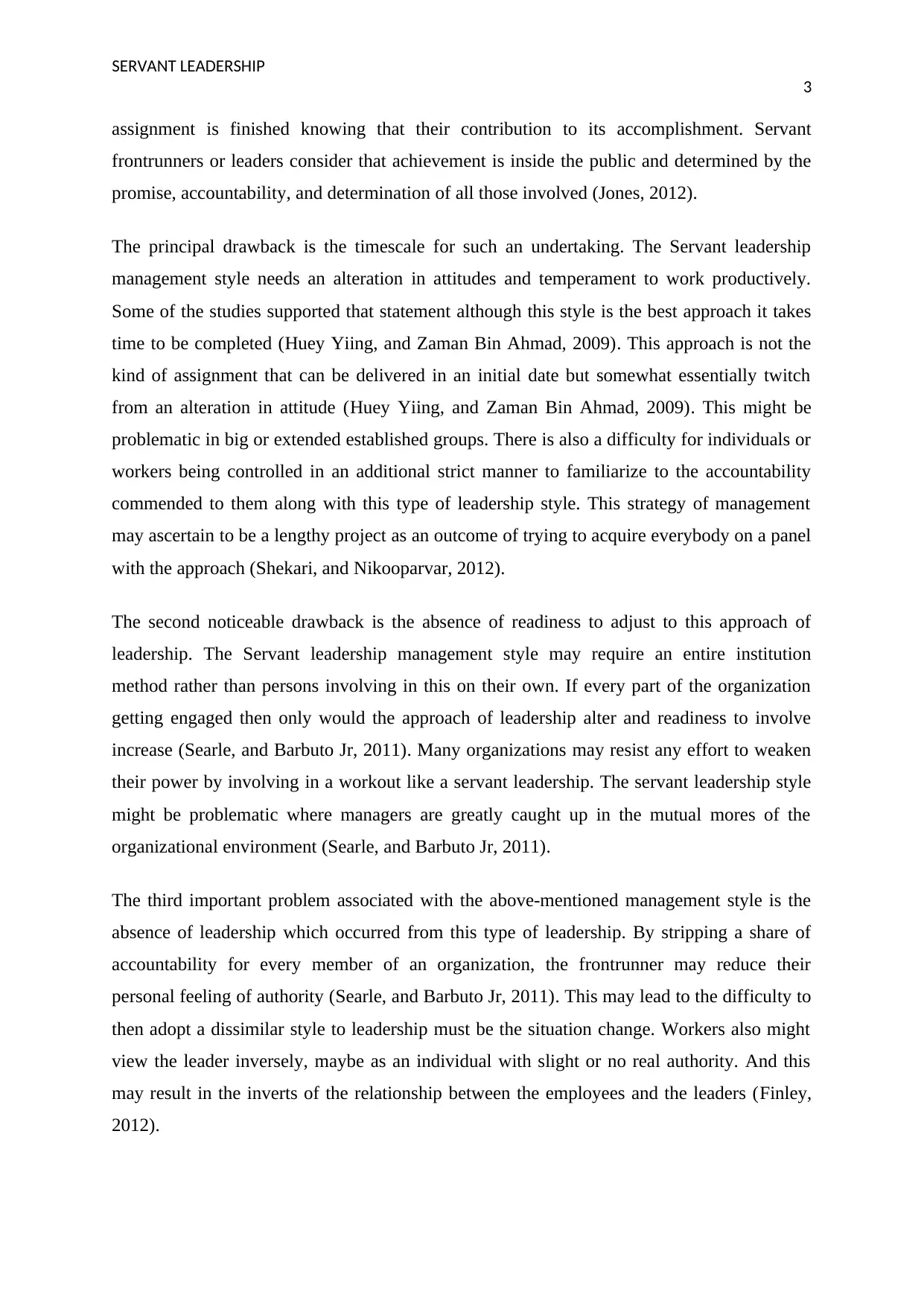
SERVANT LEADERSHIP
3
assignment is finished knowing that their contribution to its accomplishment. Servant
frontrunners or leaders consider that achievement is inside the public and determined by the
promise, accountability, and determination of all those involved (Jones, 2012).
The principal drawback is the timescale for such an undertaking. The Servant leadership
management style needs an alteration in attitudes and temperament to work productively.
Some of the studies supported that statement although this style is the best approach it takes
time to be completed (Huey Yiing, and Zaman Bin Ahmad, 2009). This approach is not the
kind of assignment that can be delivered in an initial date but somewhat essentially twitch
from an alteration in attitude (Huey Yiing, and Zaman Bin Ahmad, 2009). This might be
problematic in big or extended established groups. There is also a difficulty for individuals or
workers being controlled in an additional strict manner to familiarize to the accountability
commended to them along with this type of leadership style. This strategy of management
may ascertain to be a lengthy project as an outcome of trying to acquire everybody on a panel
with the approach (Shekari, and Nikooparvar, 2012).
The second noticeable drawback is the absence of readiness to adjust to this approach of
leadership. The Servant leadership management style may require an entire institution
method rather than persons involving in this on their own. If every part of the organization
getting engaged then only would the approach of leadership alter and readiness to involve
increase (Searle, and Barbuto Jr, 2011). Many organizations may resist any effort to weaken
their power by involving in a workout like a servant leadership. The servant leadership style
might be problematic where managers are greatly caught up in the mutual mores of the
organizational environment (Searle, and Barbuto Jr, 2011).
The third important problem associated with the above-mentioned management style is the
absence of leadership which occurred from this type of leadership. By stripping a share of
accountability for every member of an organization, the frontrunner may reduce their
personal feeling of authority (Searle, and Barbuto Jr, 2011). This may lead to the difficulty to
then adopt a dissimilar style to leadership must be the situation change. Workers also might
view the leader inversely, maybe as an individual with slight or no real authority. And this
may result in the inverts of the relationship between the employees and the leaders (Finley,
2012).
3
assignment is finished knowing that their contribution to its accomplishment. Servant
frontrunners or leaders consider that achievement is inside the public and determined by the
promise, accountability, and determination of all those involved (Jones, 2012).
The principal drawback is the timescale for such an undertaking. The Servant leadership
management style needs an alteration in attitudes and temperament to work productively.
Some of the studies supported that statement although this style is the best approach it takes
time to be completed (Huey Yiing, and Zaman Bin Ahmad, 2009). This approach is not the
kind of assignment that can be delivered in an initial date but somewhat essentially twitch
from an alteration in attitude (Huey Yiing, and Zaman Bin Ahmad, 2009). This might be
problematic in big or extended established groups. There is also a difficulty for individuals or
workers being controlled in an additional strict manner to familiarize to the accountability
commended to them along with this type of leadership style. This strategy of management
may ascertain to be a lengthy project as an outcome of trying to acquire everybody on a panel
with the approach (Shekari, and Nikooparvar, 2012).
The second noticeable drawback is the absence of readiness to adjust to this approach of
leadership. The Servant leadership management style may require an entire institution
method rather than persons involving in this on their own. If every part of the organization
getting engaged then only would the approach of leadership alter and readiness to involve
increase (Searle, and Barbuto Jr, 2011). Many organizations may resist any effort to weaken
their power by involving in a workout like a servant leadership. The servant leadership style
might be problematic where managers are greatly caught up in the mutual mores of the
organizational environment (Searle, and Barbuto Jr, 2011).
The third important problem associated with the above-mentioned management style is the
absence of leadership which occurred from this type of leadership. By stripping a share of
accountability for every member of an organization, the frontrunner may reduce their
personal feeling of authority (Searle, and Barbuto Jr, 2011). This may lead to the difficulty to
then adopt a dissimilar style to leadership must be the situation change. Workers also might
view the leader inversely, maybe as an individual with slight or no real authority. And this
may result in the inverts of the relationship between the employees and the leaders (Finley,
2012).
Paraphrase This Document
Need a fresh take? Get an instant paraphrase of this document with our AI Paraphraser
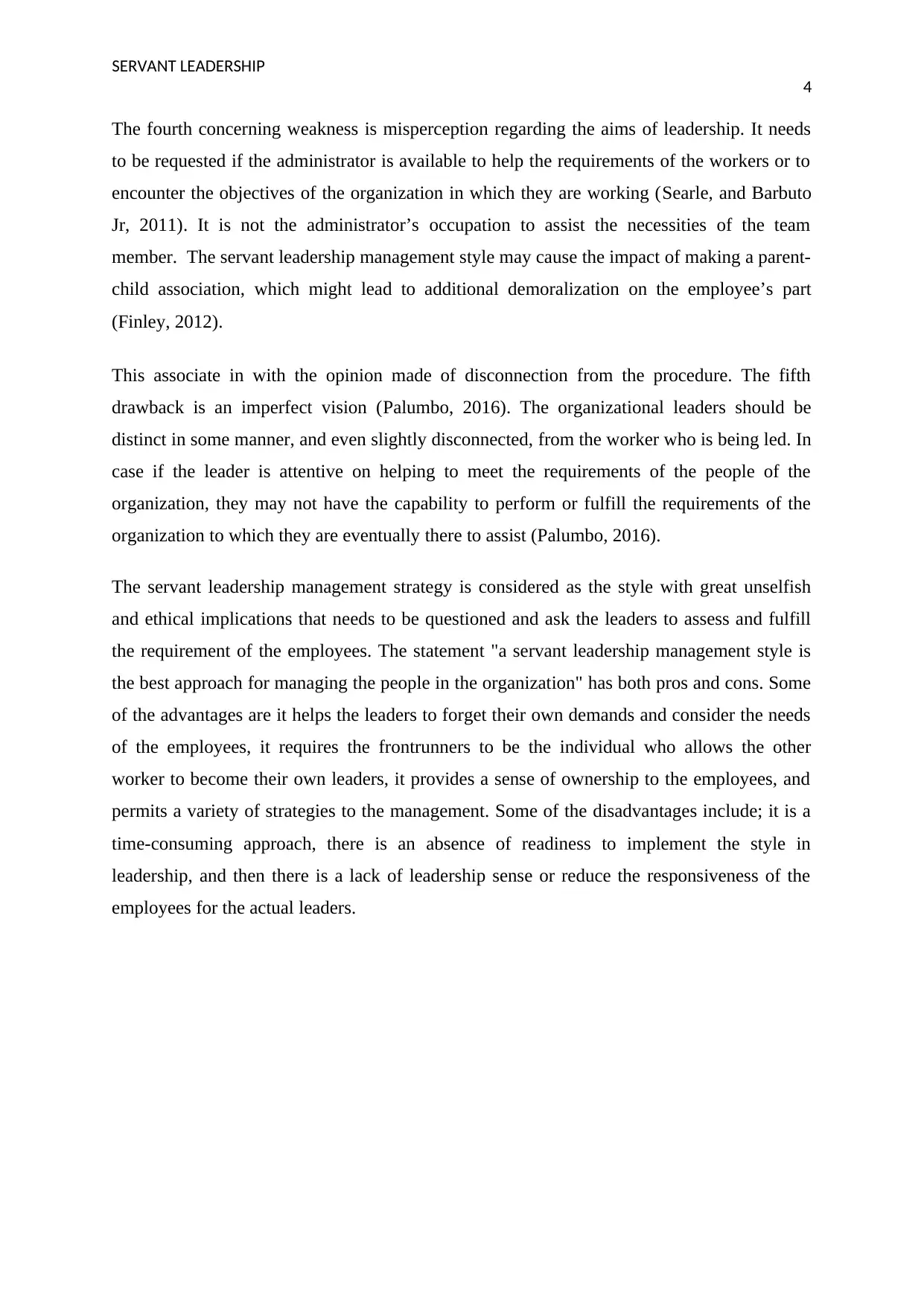
SERVANT LEADERSHIP
4
The fourth concerning weakness is misperception regarding the aims of leadership. It needs
to be requested if the administrator is available to help the requirements of the workers or to
encounter the objectives of the organization in which they are working (Searle, and Barbuto
Jr, 2011). It is not the administrator’s occupation to assist the necessities of the team
member. The servant leadership management style may cause the impact of making a parent-
child association, which might lead to additional demoralization on the employee’s part
(Finley, 2012).
This associate in with the opinion made of disconnection from the procedure. The fifth
drawback is an imperfect vision (Palumbo, 2016). The organizational leaders should be
distinct in some manner, and even slightly disconnected, from the worker who is being led. In
case if the leader is attentive on helping to meet the requirements of the people of the
organization, they may not have the capability to perform or fulfill the requirements of the
organization to which they are eventually there to assist (Palumbo, 2016).
The servant leadership management strategy is considered as the style with great unselfish
and ethical implications that needs to be questioned and ask the leaders to assess and fulfill
the requirement of the employees. The statement "a servant leadership management style is
the best approach for managing the people in the organization" has both pros and cons. Some
of the advantages are it helps the leaders to forget their own demands and consider the needs
of the employees, it requires the frontrunners to be the individual who allows the other
worker to become their own leaders, it provides a sense of ownership to the employees, and
permits a variety of strategies to the management. Some of the disadvantages include; it is a
time-consuming approach, there is an absence of readiness to implement the style in
leadership, and then there is a lack of leadership sense or reduce the responsiveness of the
employees for the actual leaders.
4
The fourth concerning weakness is misperception regarding the aims of leadership. It needs
to be requested if the administrator is available to help the requirements of the workers or to
encounter the objectives of the organization in which they are working (Searle, and Barbuto
Jr, 2011). It is not the administrator’s occupation to assist the necessities of the team
member. The servant leadership management style may cause the impact of making a parent-
child association, which might lead to additional demoralization on the employee’s part
(Finley, 2012).
This associate in with the opinion made of disconnection from the procedure. The fifth
drawback is an imperfect vision (Palumbo, 2016). The organizational leaders should be
distinct in some manner, and even slightly disconnected, from the worker who is being led. In
case if the leader is attentive on helping to meet the requirements of the people of the
organization, they may not have the capability to perform or fulfill the requirements of the
organization to which they are eventually there to assist (Palumbo, 2016).
The servant leadership management strategy is considered as the style with great unselfish
and ethical implications that needs to be questioned and ask the leaders to assess and fulfill
the requirement of the employees. The statement "a servant leadership management style is
the best approach for managing the people in the organization" has both pros and cons. Some
of the advantages are it helps the leaders to forget their own demands and consider the needs
of the employees, it requires the frontrunners to be the individual who allows the other
worker to become their own leaders, it provides a sense of ownership to the employees, and
permits a variety of strategies to the management. Some of the disadvantages include; it is a
time-consuming approach, there is an absence of readiness to implement the style in
leadership, and then there is a lack of leadership sense or reduce the responsiveness of the
employees for the actual leaders.
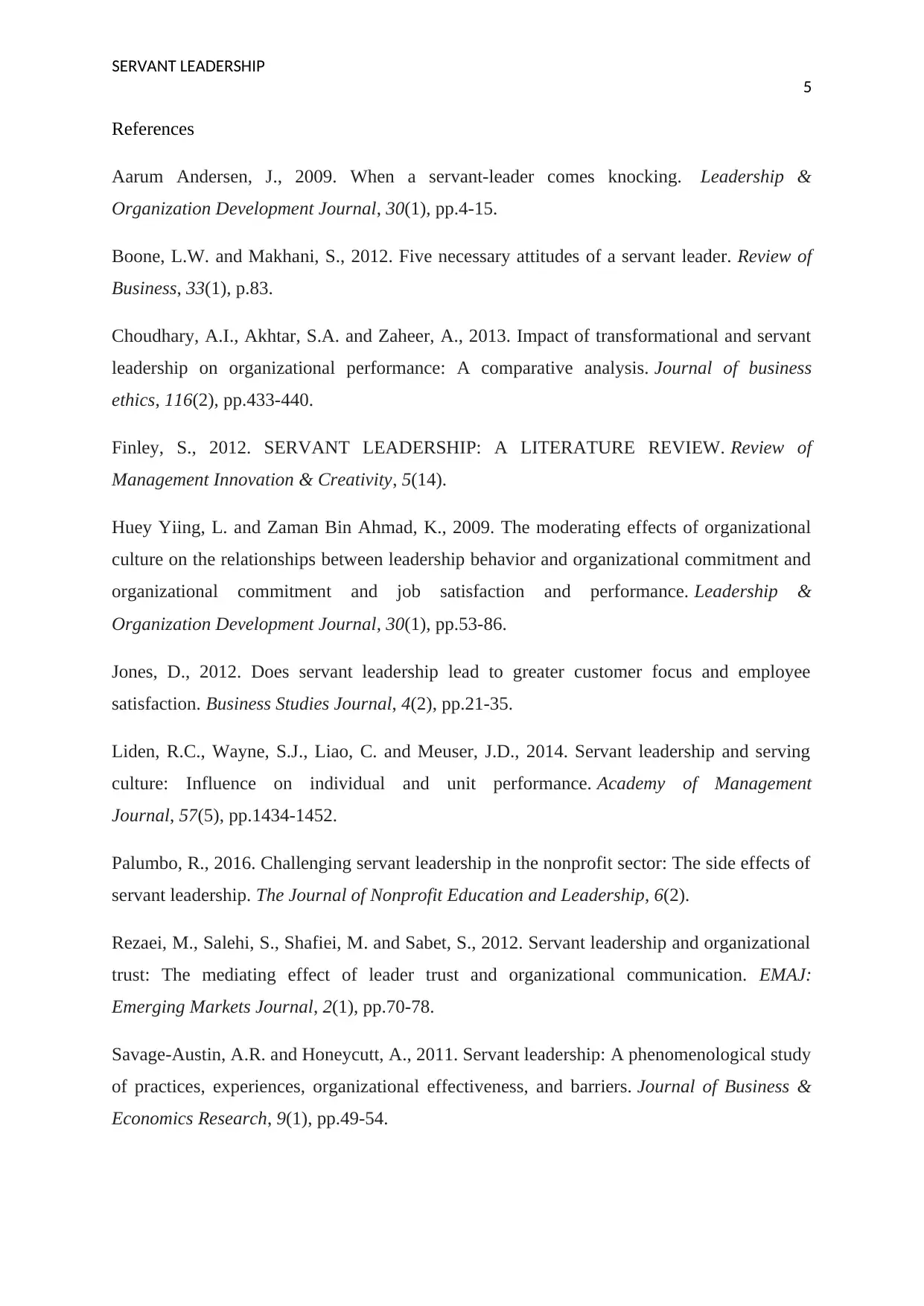
SERVANT LEADERSHIP
5
References
Aarum Andersen, J., 2009. When a servant-leader comes knocking. Leadership &
Organization Development Journal, 30(1), pp.4-15.
Boone, L.W. and Makhani, S., 2012. Five necessary attitudes of a servant leader. Review of
Business, 33(1), p.83.
Choudhary, A.I., Akhtar, S.A. and Zaheer, A., 2013. Impact of transformational and servant
leadership on organizational performance: A comparative analysis. Journal of business
ethics, 116(2), pp.433-440.
Finley, S., 2012. SERVANT LEADERSHIP: A LITERATURE REVIEW. Review of
Management Innovation & Creativity, 5(14).
Huey Yiing, L. and Zaman Bin Ahmad, K., 2009. The moderating effects of organizational
culture on the relationships between leadership behavior and organizational commitment and
organizational commitment and job satisfaction and performance. Leadership &
Organization Development Journal, 30(1), pp.53-86.
Jones, D., 2012. Does servant leadership lead to greater customer focus and employee
satisfaction. Business Studies Journal, 4(2), pp.21-35.
Liden, R.C., Wayne, S.J., Liao, C. and Meuser, J.D., 2014. Servant leadership and serving
culture: Influence on individual and unit performance. Academy of Management
Journal, 57(5), pp.1434-1452.
Palumbo, R., 2016. Challenging servant leadership in the nonprofit sector: The side effects of
servant leadership. The Journal of Nonprofit Education and Leadership, 6(2).
Rezaei, M., Salehi, S., Shafiei, M. and Sabet, S., 2012. Servant leadership and organizational
trust: The mediating effect of leader trust and organizational communication. EMAJ:
Emerging Markets Journal, 2(1), pp.70-78.
Savage-Austin, A.R. and Honeycutt, A., 2011. Servant leadership: A phenomenological study
of practices, experiences, organizational effectiveness, and barriers. Journal of Business &
Economics Research, 9(1), pp.49-54.
5
References
Aarum Andersen, J., 2009. When a servant-leader comes knocking. Leadership &
Organization Development Journal, 30(1), pp.4-15.
Boone, L.W. and Makhani, S., 2012. Five necessary attitudes of a servant leader. Review of
Business, 33(1), p.83.
Choudhary, A.I., Akhtar, S.A. and Zaheer, A., 2013. Impact of transformational and servant
leadership on organizational performance: A comparative analysis. Journal of business
ethics, 116(2), pp.433-440.
Finley, S., 2012. SERVANT LEADERSHIP: A LITERATURE REVIEW. Review of
Management Innovation & Creativity, 5(14).
Huey Yiing, L. and Zaman Bin Ahmad, K., 2009. The moderating effects of organizational
culture on the relationships between leadership behavior and organizational commitment and
organizational commitment and job satisfaction and performance. Leadership &
Organization Development Journal, 30(1), pp.53-86.
Jones, D., 2012. Does servant leadership lead to greater customer focus and employee
satisfaction. Business Studies Journal, 4(2), pp.21-35.
Liden, R.C., Wayne, S.J., Liao, C. and Meuser, J.D., 2014. Servant leadership and serving
culture: Influence on individual and unit performance. Academy of Management
Journal, 57(5), pp.1434-1452.
Palumbo, R., 2016. Challenging servant leadership in the nonprofit sector: The side effects of
servant leadership. The Journal of Nonprofit Education and Leadership, 6(2).
Rezaei, M., Salehi, S., Shafiei, M. and Sabet, S., 2012. Servant leadership and organizational
trust: The mediating effect of leader trust and organizational communication. EMAJ:
Emerging Markets Journal, 2(1), pp.70-78.
Savage-Austin, A.R. and Honeycutt, A., 2011. Servant leadership: A phenomenological study
of practices, experiences, organizational effectiveness, and barriers. Journal of Business &
Economics Research, 9(1), pp.49-54.
⊘ This is a preview!⊘
Do you want full access?
Subscribe today to unlock all pages.

Trusted by 1+ million students worldwide
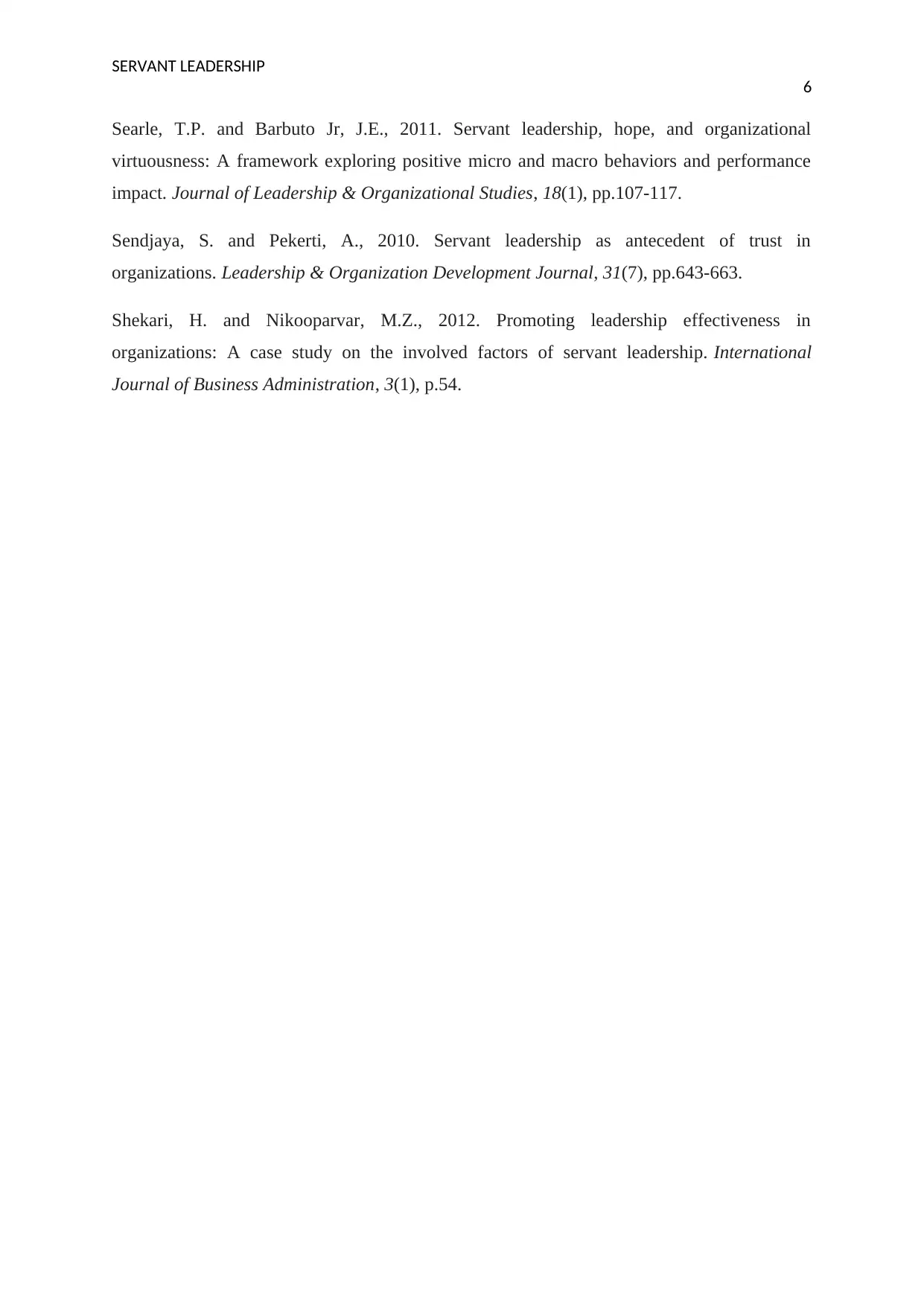
SERVANT LEADERSHIP
6
Searle, T.P. and Barbuto Jr, J.E., 2011. Servant leadership, hope, and organizational
virtuousness: A framework exploring positive micro and macro behaviors and performance
impact. Journal of Leadership & Organizational Studies, 18(1), pp.107-117.
Sendjaya, S. and Pekerti, A., 2010. Servant leadership as antecedent of trust in
organizations. Leadership & Organization Development Journal, 31(7), pp.643-663.
Shekari, H. and Nikooparvar, M.Z., 2012. Promoting leadership effectiveness in
organizations: A case study on the involved factors of servant leadership. International
Journal of Business Administration, 3(1), p.54.
6
Searle, T.P. and Barbuto Jr, J.E., 2011. Servant leadership, hope, and organizational
virtuousness: A framework exploring positive micro and macro behaviors and performance
impact. Journal of Leadership & Organizational Studies, 18(1), pp.107-117.
Sendjaya, S. and Pekerti, A., 2010. Servant leadership as antecedent of trust in
organizations. Leadership & Organization Development Journal, 31(7), pp.643-663.
Shekari, H. and Nikooparvar, M.Z., 2012. Promoting leadership effectiveness in
organizations: A case study on the involved factors of servant leadership. International
Journal of Business Administration, 3(1), p.54.
1 out of 7
Related Documents
Your All-in-One AI-Powered Toolkit for Academic Success.
+13062052269
info@desklib.com
Available 24*7 on WhatsApp / Email
![[object Object]](/_next/static/media/star-bottom.7253800d.svg)
Unlock your academic potential
© 2024 | Zucol Services PVT LTD | All rights reserved.





